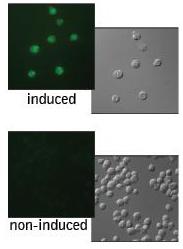
 FAM-FLICA™ Caspase-1 Assay Kit
FAM-FLICA™ Caspase-1 Assay Kit
98
100 tests
Brand
ImmunoChemistry
Description
Caspase 1 (ICE)
Members of the mammalian caspase family of cysteinyl aspartate-specific proteases play distinct roles in apoptosis and inflammation. Originally identified as Interleukin -1β Converting Enzyme or ICE (1, 2), caspase 1 along with caspases 4, 5, and 12 comprise the inflammatory subfamily of caspase enzymes (3). In rodents, caspase 11 is also an inflammatory caspase (3).
Caspase 1 has also been found to play a role in processing a wide variety of proteins, most notably several cytokines (4-6) and enzymes within the glycolytic pathway (7). The creation of the inflammasome during host responses to pathogens leads to the activation of caspase 1 (8, 9) and may induce the class of cell death known as pyroptosis. Caspase 1-mediated cleavage of the pro-inflammatory cytokine interleukin 1 beta (IL-1β) results in the biologically active form of this critical immune response regulator. Furthermore, inflammation-related disease models have illustrated a role for caspase 1 in asthma, rheumatoid arthritis, multiple sclerosis and other disorders (8, 9).
Like other caspase family members, caspase 1 is a heterodimer comprised of two subunits, 20 kDa and 10 kDa in size (10, 11). Caspase 1 is autocatalytically activated following oligomerization. Active caspase enzymes exhibit catalytic and substrate specificities comprised of short tetra-peptide amino acid sequences that must contain an aspartate in the P1 position (12 – 14). These preferred tetra-peptide sequences have been used to derive peptides that specifically compete for caspase binding (15 – 17). In addition to the distinctive aspartate cleavage site at P1, the catalytic domains of the caspases typically require four amino acids to the left of the cleavage site with P4 as the prominent specificity-determining residue (14). Most inflammatory caspases prefer a hydrophobic amino acid such as tyrosine or tryptophan in the P4 position (14). Addition of a fluoromethyl ketone (FMK) to the tetrapeptide results in an irreversible linkage and permanent inactivation of the cysteine protease enzyme (18). Furthermore, conjugation of a fluorescent moiety at the amino terminus yields a probe that allows for the detection of caspase 1 activity (19 – 21).
Application
Reactivity




